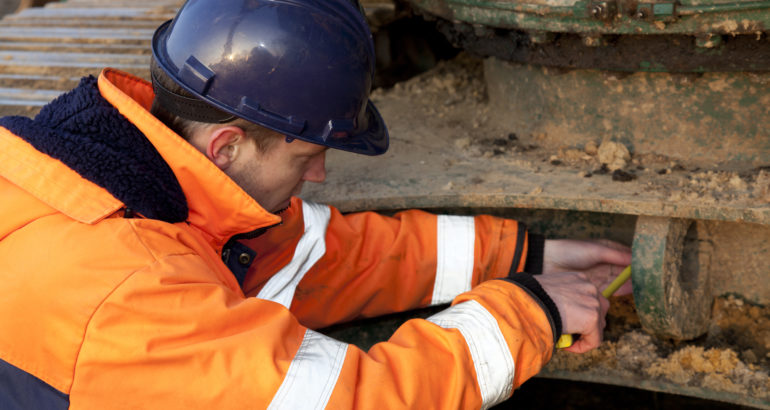Cranes are a major concern for any marine construction project. However, most of these accidents are the result of personnel error and many can be avoided. Accidents can occur at any phase of the project from driving sheet piling for a simple bulkhead or seawall from land to the most hazardous projects that involve a crane mounted on a barge, working on a bridge project, cofferdam or other “on water structure”.
To ensure that a crane is operated safely it is critical that you have effective teamwork. This is because most accidents are caused by a team member failing to perform an action properly. So who are the players?
Rigger
The rigger in charge has overall control of the operation including: planning all aspects of the lift; determining the weight of the load to be lifted; establishing the appropriate method of communication with the operator; ensuring the load is properly rigged; ensuring the crane operating envelope remains clear of all obstructions; providing signals to the operator or assigning another rigger or signal person to provide the signals; and conducting the operation in a safe manner. The rigger-in-charge shall coordinate the activities of other crane team members.
Crane Rigger
The crane rigger is responsible for carrying out the assignments from the rigger-in-charge or the rigger supervisor, including: assisting the crane operator in performing his pre-use check of the crane; proper gear selection and inspection prior to use; safe rigging of the load; and keeping the rigger-in-charge informed of questionable conditions associated with the operation.
Crane Walker
Crane walker responsibilities include: assisting the rigger and operator in the pre-use check of the crane; and ensuring the safe travel of the crane by observing for potential obstructions, properly aligning crane rail switches, and being in a position to immediately notify the operator to stop operations should a potential problem arise.
Operator Responsibilities
The primary responsibility of the operator is the safe operation of the crane. Operator responsibilities include: performing a pre-use check of the crane at the start of the shift; fully understanding the lift prior to starting, including participating in pre-lift briefings; maintaining communication with the rigger-in-charge or designated rigger throughout the operation; making movements only when given the direction to do so and refusing to operate the crane when there are concerns about the safety of the operation.
Operator Condition
First and perhaps most important, the operator shall, by self
-examination, determine whether he/she is physically, mentally, and emotionally fit to operate the machine. Many lives may be dependent on the operator’s actions. The operator should ask his/her self daily:
- Do I feel well?
- Can I handle the tasks of operating?
- Do I have a clear head?
- Am I thinking and remembering properly?
- Am I alert?
- Is my attitude good today?
- Am I calm, cool, and collected?
If an operator cannot honestly answer yes to these questions, operating a crane could result in an accident.
Understanding the Crane
Generally, crane operators are required to operate various types, makes, and models of cranes. The operator should be familiar with the operating characteristics, including posted operational restrictions or limitations, of each type of crane that may be operated.
Safety Devices
There are many safety devices on cranes. Many safety systems require thorough training on their operations. This is especially true on mobile cranes that are often leased or rented for short term use. Activities should ensure, through training, pre-briefs, spot checks, or performance examination, that operators and supervisors are knowledgeable of the operation of safety systems on assigned cranes. It cannot be presumed
That knowledge of a system on one crane indicates adequate knowledge on other cranes.
Operators shall fully understand that safety devices such as interlocks and limit switches shall not be used as operational controls. They are not a substitute for full attention by the operator to potential hazards.
Operators shall be trained to approach limit switches (hoist, rotate, and travel) only at slow speed. Additionally, each activity shall develop procedures for controlling the bypassing of safety devices.
Supervisors shall control the usage of keys for safety device bypassing. Keys shall be removed from the bypass switches when not in use. The keys shall be removed from the crane and shall be retained by the supervisor unless unique activity operations (e.g., operating mobile cranes at remote sites) require that the keys remain on the crane.
Where this is not practical or where safety devices may be bypassed by other means, permission for bypassing/defeating safety devices (except for performance of the operator’s pre-operation inspection) shall be obtained from the operator supervisor. This requirement shall be posted in the operator’s cab.
For mobile and electric cranes that do not provide protection against two-blocking, activities shall develop crane specific procedures designed to minimize the possibility of two-blocking (e.g., prohibiting hoisting when hook block is within 10 feet of contacting the boom or 3 feet from contacting the hoist frame, providing a rigger to watch the hook block when the hook approaches the boom or hoist frame, prohibiting any simultaneous crane movement while hoisting, etc.). Supervisors shall brief operators on the procedures prior to assignment on such cranes.









